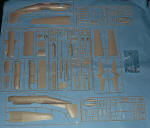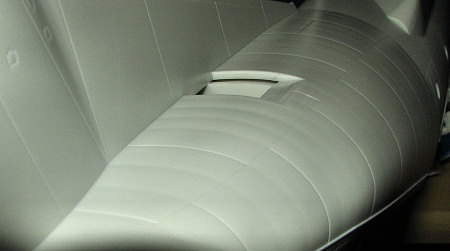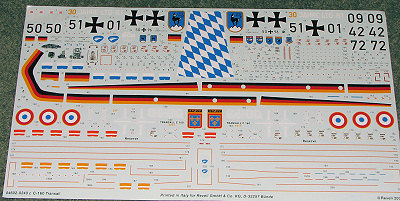
| KIT: | Revell 1/72 C-160 D/F Transall |
| KIT #: | 04602 |
| PRICE: | 6200 yen from www.hlj.com |
| DECALS: | Five options |
| REVIEWER: | Scott Van Aken |
| NOTES: | New Mold |

| HISTORY |
The Transport Allianz Transall C-160 is a military transport aircraft developed by a consortium of French and German aircraft manufacturers for the air forces of those two nations and that of South Africa. The name Transall comes from the contraction of Transport Allianz.
The C-160 was originally conceived as a replacement for the Armée de l'Air's Nord Noratlas fleet. It is turboprop-powered and of conventional configuration for aircraft of this type, with high wings, and a loading ramp built into the rear of the fuselage. Size-wise, it falls between the Aeritalia G.222 and the C-130 Hercules, but is a lot closer to the Hercules, thanks to its long wingspan.
Three prototypes flew in 1963, followed by pre-production machines in 1965 and production machines from 1967. The first batch included 110 C-160Ds for the Luftwaffe, 50 C-160Fs for the Armée de l'Air, and 9 C-160Zs for the South African Air Force, 4 C-160Fs were converted to air mail transport aircraft, they were operated by Air France and given the designation C-160P. Production continued until 1972 with French aircraft built by Aérospatiale and German aircraft by Messerschmitt-Bölkow-Blohm.
In 1977, the Armée de l'Air ordered an updated version (designated C-160NG, for Nouvelle Génération - "New Generation"). From 1981, 29 of these aircraft were delivered, half of them configured as tanker aircraft for aerial refueling. Another 4 were configured as C-160H TACAMO aircraft, for communication with submerged submarines. Finally, 2 more were converted to SIGINT electronic surveillance aircraft, designated C-160G Gabriel, replacing the Noratlases that had been in this role previously. While still new, the C-160Gs took part in the Gulf War of 1991.
From 1994 to 1999, all French C-160s underwent an avionics upgrade and the addition of new anti-missile countermeasures. The C-160Fs and NGs so updated were redesignated C-160R (Renové - "renovated"). Luftwaffe machines have similarly undergone life-extension programmes by BAE Systems, but all French and German machines are reaching the end of their service lives as of 2004. All South African machines have already been retired, while the Turkish Air Force continues to operate 20 machines obtained from Germany (C-160T).
| THE KIT |
 Revell of Germany continues to amaze us by producing kits of very large aircraft and very reasonable prices. Not only that, but the general quality of the kits is superb. This one has crisply etched detail and a plethora of parts that include not only a full cockpit, but a full cargo area as well. This latter area is not just a plain wall, but includes all the convolutions and fixtures that one sees inside modern cargo aircraft. It is a pity that this kit has come out now when the aircraft is at the end of its useful career, but better late than never. Of course, this isn't the only injected 1/72 C-160 ever made as Heller produced a kit back in the raised panel line era. It was no where near as well detailed and actually had main wheels that were only 3/4 complete with one whole sidewall hollowed out. Rather toy-like if you ask me.
Revell of Germany continues to amaze us by producing kits of very large aircraft and very reasonable prices. Not only that, but the general quality of the kits is superb. This one has crisply etched detail and a plethora of parts that include not only a full cockpit, but a full cargo area as well. This latter area is not just a plain wall, but includes all the convolutions and fixtures that one sees inside modern cargo aircraft. It is a pity that this kit has come out now when the aircraft is at the end of its useful career, but better late than never. Of course, this isn't the only injected 1/72 C-160 ever made as Heller produced a kit back in the raised panel line era. It was no where near as well detailed and actually had main wheels that were only 3/4 complete with one whole sidewall hollowed out. Rather toy-like if you ask me.
 But this is not the Heller kit and with over 200 parts, it is also not going to be a weekend build. It will be interesting to know just what the percentage of people will actually build a kit of this size. I'd wager under 10 % of these kits sold will be completed. Regardless, it is a superb offering and all that one could ask. I should point out that the kit is not without its molding problems. Since there is large and heavy ribbing detail on the inside of the rear ramp area, there are the inevitable sink areas. In fact, it is like a washboard along the upper rear fuselage area. It can be filled and smoothed of course, but will take time and will eradicate detail.
But this is not the Heller kit and with over 200 parts, it is also not going to be a weekend build. It will be interesting to know just what the percentage of people will actually build a kit of this size. I'd wager under 10 % of these kits sold will be completed. Regardless, it is a superb offering and all that one could ask. I should point out that the kit is not without its molding problems. Since there is large and heavy ribbing detail on the inside of the rear ramp area, there are the inevitable sink areas. In fact, it is like a washboard along the upper rear fuselage area. It can be filled and smoothed of course, but will take time and will eradicate detail.
Revell has done a good job getting rid of ejector pin marks from the visible areas of most parts. I say most as all pieces of any size have these marks on one side. This shows on a few parts, but that number is mercifully tiny. As it is a large aircraft and tail-heavy, you need to install at least 40 grams of weight in the nose section. There isn't a lot of room to do that, so you need to be particularly clever on how you cut up and place the weight. As the C-160 has a relatively flat nose, not much can be stuffed into the radome.
 Instructions are well done and consist of a mere 72 construction and painting steps. Revell AG continues the irritating habit of only listing Revell paints (available no where outside Europe) and requires many mixings. It would be nice to at least have the RAL or French colors, but even this is denied us. A monsterous decal sheet provides markings for five aircraft. Four are German and all in the original paint scheme, not the later lower-viz lizard ones. The French aircraft also is in the earlier markings with the larger insignia and code letters. This kit does not build into a probed NG aircraft.
Instructions are well done and consist of a mere 72 construction and painting steps. Revell AG continues the irritating habit of only listing Revell paints (available no where outside Europe) and requires many mixings. It would be nice to at least have the RAL or French colors, but even this is denied us. A monsterous decal sheet provides markings for five aircraft. Four are German and all in the original paint scheme, not the later lower-viz lizard ones. The French aircraft also is in the earlier markings with the larger insignia and code letters. This kit does not build into a probed NG aircraft.
 Let me start with the lone French aircraft. It s F 217 of ET2/64 with the large badge on the tail. This image to the left shows this same plane after conversion to the C-160 NG variant but with the same serial and codes, though the later variety. It also carries a different unit badge so may have been with one of the other squadrons inside ET 64. I'm thinking the codes should be in yellow though they are given in white. Feedback appreciated on this.
Let me start with the lone French aircraft. It s F 217 of ET2/64 with the large badge on the tail. This image to the left shows this same plane after conversion to the C-160 NG variant but with the same serial and codes, though the later variety. It also carries a different unit badge so may have been with one of the other squadrons inside ET 64. I'm thinking the codes should be in yellow though they are given in white. Feedback appreciated on this.
 The main German plane is the box art one celebrating the 30th Anniversary of LTG 61 back in 1987. It has the very large rudder marking and fuselage cheat line. It also has prop tips in blue and white. The decal sheet provides prop tip markings in three colors depending on the application.
The main German plane is the box art one celebrating the 30th Anniversary of LTG 61 back in 1987. It has the very large rudder marking and fuselage cheat line. It also has prop tips in blue and white. The decal sheet provides prop tip markings in three colors depending on the application.
 Next, there are three standard looking aircraft. When the planes were originally built, they had large da-glo patches on the rudder, engine nacelles, wing tips and forward sponsons. The other LTG 61 aircraft has these markings and the photo, taken in 1989 of a different LTG 61 aircraft, shows an example of this. The white patches under the wings are ice from where the fuel tanks are located.
Next, there are three standard looking aircraft. When the planes were originally built, they had large da-glo patches on the rudder, engine nacelles, wing tips and forward sponsons. The other LTG 61 aircraft has these markings and the photo, taken in 1989 of a different LTG 61 aircraft, shows an example of this. The white patches under the wings are ice from where the fuel tanks are located.
 Eventually, there were three transportation groups operating the C-160 in Germany. The second was LTG 62 of which I just happen to have a photo of the aircraft on the decal sheet that was photographed in 1981. These aircraft generally differed only by the unit badge on the nose. Tail badges were all the same.
Eventually, there were three transportation groups operating the C-160 in Germany. The second was LTG 62 of which I just happen to have a photo of the aircraft on the decal sheet that was photographed in 1981. These aircraft generally differed only by the unit badge on the nose. Tail badges were all the same.
The last aircraft is from LTG 63 and depicts an aircraft participating in the Volant Rodeo competition held in the US in 1982. I don't have a photo of this one in the old scheme so did not include it. The decals themselves are printed in Italy and should work quite well. The data and stencil markings for it are quite extensive. I should also point out that there are a number of these markings that go into the cargo hold. Those that do not read through instructions prior to building the kit will end up with the kit built and no way to install most of those decals. Now Revell does have guide labeled 'BS 67' that tells you to go to that construction step, but like most, I was pretty clueless as to what that actually stood for until I noodled it out.
| CONCLUSIONS |
I'm sure this kit will sell well. It is superbly done and I doubt we'll see it done again. I hope the after market crowd will provide updates and markings for other planes as it will allow some rather interesting types to be done. Regardless, this one is a beauty and if you love big transports, you'll go for this one.
March 2007
| REFERENCES |
The internet and Wikipedia.
My thanks toHobby Link Japan for providing the review kit. Get yours at Japanese prices.
for providing the review kit. Get yours at Japanese prices.
If you would like your product reviewed fairly and fairly quickly by asite that has over 350,000 visitors a month, please contactme or see other details in the